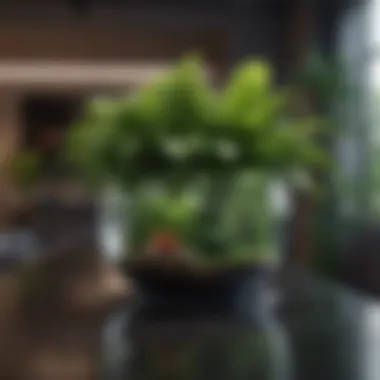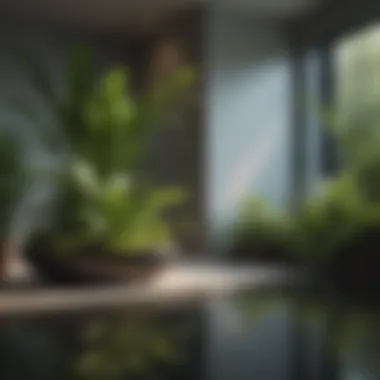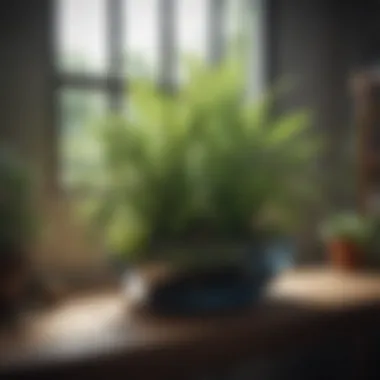The Best Indoor Water Plants for Your Home


Intro
Indoor water plants create a wonderful atmosphere while offering distinct advantages. They not only beautify your space, but they also contribute positively to your air quality and overall mood. With the growing awareness of design choices that promote well-being, integrating water plants into your home has gained traction. This guide will explore various types of indoor water plants, their care requirements, and how they fit into your home. By the end, you'll have a solid understanding of how to choose and maintain these plants effectively.
Design Inspiration
Indoor water plants offer flexibility in design and style. They can be tailored to match different aesthetics, ranging from modern minimalism to lush tropical vibes. Here we will explore trending styles and color palettes that can accentuate your indoor spaces.
Trending Styles
Selecting indoor water plants can align with various design themes in your home. Here are a few styles worth considering:
- Zen-inspired: Utilize plants like the Bamboo Palm or Lucky Bamboo to create tranquility.
- Industrial Chic: Opt for plants stored in metal or glass setups to match raw and unfinished decor.
- Tropical Retreat: Incorporate larger varieties like Water Lilies or Lotus plants for a lush feel.
Combining these plants with appropriate containers enhances the overall ambiance. The choice of pot or vessel is crucial as it defines the style statement and complements the plant's natural beauty.
Color Palettes
When incorporating indoor water plants, consider the colors that harmonize your space.
- Earthy tones: Soft browns and greens work well to create a calm feel.
- Bright contrasts: Pinks or whites from flowering water plants can add liveliness.
- Monochromatic schemes: Shades of green can create depth and sophistication.
Thoughtful selections in color not only serve aesthetic purposes but can also impact emotions and perceptions in a given space.
Practical Tips
Maintaining indoor water plants requires knowledge and planning. This section will provide insights into care, budgeting, and planning for successful integration.
Maintenance & Care
Ensuring the health of indoor water plants is essential. Here are some care tips:
- Water quality: Use distilled or filtered water to prevent harmful build-up.
- Nutrient needs: Some plants may need fertilizers. Consider liquid fertilizers specially formulated for aquatic plants.
- Light: Understand each plant's light requirements and position them accordingly.
Caring for these plants can sometimes seem daunting, but regular observation and attention will yield a thriving environment.
Budgeting & Planning
Planning ahead is crucial when choosing indoor water plants. Here are some budgeting considerations:
- Initial cost: Research plant prices and required containers.
- Ongoing expenses: Account for the cost of fertilizers and water quality treatment.
- Growth impact: Recognize that as plants grow, larger containers or more substantial setups will be needed.
Being prepared for these aspects will lead to more satisfying results and reduce potential frustrations in the gardening process.
"Indoor water plants require unique care but bring remarkable benefits and beauty."
Establishing a routine for maintenance will enhance their longevity and health, making them a significant part of your home.
Prelims to Indoor Water Plants
Indoor water plants have gained popularity in recent years. This is not merely due to their aesthetic appeal, but also because of their numerous benefits. Homeowners and enthusiasts alike are discovering how these plants can positively impact their living spaces.
These plants can enhance air quality, improve overall well-being, and add a touch of nature to homes. They bring a sense of tranquility that can be hard to find amid the hustle and bustle of daily life. When selecting indoor water plants, it is important to consider various factors such as light, space, and maintenance needs. This article will explore these aspects deeply, providing a comprehensive guide.
The Appeal of Indoor Water Plants
Indoor water plants make an impression. They are not just decoration; they can transform a room. The reflection of leaves on the water’s surface brings serenity. Let’s not discount the potential of these plants for fostering creativity. A small indoor water garden can stimulate the mind and calm the spirit.
Some individuals underestimate the positive effects of these plants. They do wonders for indoor air quality. Certain species can remove toxins, making the air healthier.A fresh breath offers clarity.


Additionally, they also have a calming effect. Studies show that being around water, whether in a garden or aquarium, can reduce stress. This is a valuable experience in today’s fast-paced world.
Understanding Aquatic Plant Biology
To maintain healthy indoor water plants, knowledge of their biology is essential. Aquatic plants have developed unique adaptations over time. They absorb nutrients and oxygen differently compared to terrestrial plants.
The roots of these plants often sit in water, allowing them to extract what they need without the need for soil. This adaptation makes them suited for various indoor environments. For enthusiasts, it’s crucial to understand each species. They have distinct requirements regarding light, temperature, and water conditions.
In summary, grasping the biology of water plants is a foundational step. This knowledge allows for proper care, ensuring that plants thrive in indoor spaces.
Types of Indoor Water Plants
Choosing the right type of indoor water plants is critical for creating a thriving indoor aquascape. Each variety brings its own distinct charm and benefits. This section will delve into popular and uncommon aquatic plants, offering insights on what makes them ideal for indoor environments. Understanding these types is not just about aesthetics; it's also about ensuring compatibility with your home's conditions, including light and space availability. With the right knowledge, homeowners can select plants that not only beautify their space but also contribute positively to their living conditions.
Popular Varieties
Water Lilies
Water Lilies, or Nymphaea, are often hailed for their stunning flowers and broad leaves. They can add a touch of elegance to any indoor water feature. These plants have a remarkable ability to float on the surface of the water, making them visually appealing. Moreover, they help in reducing algae growth by providing shade. However, they do require larger containers to accommodate their extensive root system, which could be a limitation for some home setups.
Lotus Plants
Lotus Plants, specifically the Nelumbo species, are known for their alluring and fragrant blooms. They symbolize purity and beauty. Notably, these plants thrive in warm environments and need ample sunlight to flourish. Although they may need slightly more care and attention compared to other plants, the mesmerizing flowers they produce can be worth the effort. It's crucial to choose a sizable container for their root development.
Anubias
Anubias is a versatile choice for indoor water gardening. It is exceptionally hardy and can thrive in various water conditions. This plant is particularly unique due to its slow growth rate and ability to root in different substrates. Anubias is great for beginners as it requires minimal maintenance and can flourish in lower light settings. Its thick leaves also resist algae, making it a practical option.
Java Fern
Java Fern is another popular aquatic plant, recognized for its graceful appearance. This plant is particularly well-suited to both low and moderate lighting conditions, which makes it adaptable for many indoor spaces. Java Fern does not require substrate planting, as it can be attached to rocks or driftwood. However, it may take time to establish in your setup, which can be a drawback for those looking for immediate results.
Uncommon Aquatic Plants
Marimo Moss Balls
Marimo Moss Balls are quirky and easy to care for. These spherical algae are often kept in jars or bowls, making them suitable for smaller spaces. They provide natural filtration and help improve water quality. The main appeal of Marimo Moss Balls is their unique appearance and the minimal maintenance they require. They can also withstand a range of water conditions, but they may not flower, which could disappoint some plant enthusiasts.
Lemna Minor
Also known as duckweed, Lemna Minor is a floating plant that can rapidly cover the surface of water containers. This plant's fast growth makes it a powerful filter for water. It is typically used in water gardens to control algae and improve water quality. However, its rapid spreading may require regular trimming to prevent overcrowding, which can be seen as an inconvenience by some caretakers.
Aquatic Mint
Aquatic Mint is a less common but interesting choice for indoor water gardens. It offers a refreshing scent and beautiful foliage. Unlike most aquatic plants, Aquatic Mint can provide culinary benefits as it is edible. However, it does require consistent maintenance and monitoring of water conditions, as it can be prone to overgrowth. The aroma and flavorful leaves can truly enhance the ambiance of your indoor space.
Factors to Consider When Choosing Indoor Water Plants
When selecting indoor water plants, several factors play a crucial role in ensuring your plants not only survive but thrive. Every species has its own unique requirements, and understanding these can greatly improve the success of your indoor water garden. In this section, we will discuss the importance of light conditions, space requirements, and maintenance levels, guiding homeowners and gardening enthusiasts in making informed choices.
Light Conditions
Light is vital for the growth of plants. Indoor water plants are no exception. Each variety has its specific light needs, which can vary significantly.
- Low Light Plants: Some plants, such as Anubias, can tolerate low light conditions. If you have limited natural light in your home, this type might be suitable for you.
- Moderate to Bright Light: Many aquatic plants prefer moderate to bright light to flourish. Lotus plants, for instance, require good light exposure to produce their beautiful blooms.
- Direct Sunlight: Only a few can endure full direct sunlight, and it's essential to be cautious with such environments as it might cause issues like leaf burn.
Understanding these lighting conditions ensures that you align the plant's needs with your home environment. It allows for healthier plants, rich growth, and a stunning indoor display.
Space Requirements


The amount of space you have available is another essential factor when selecting indoor water plants. These plants can vary in size, and assessing your space will help you avoid overcrowding and ensure the health of your plants.
- Container Size: Larger plants often require more substantial containers to accommodate root systems. Water lilies typically need wider containers, allowing for optimal growth.
- Height Considerations: Some plants, like the lotus, can grow tall. Make sure you have enough vertical space, especially if you place your plants on shelves or tables.
- Aquatic Landscapes: Consider how you want to arrange your indoor water garden. Make sure it has enough space to breath, allowing plants to flourish without competing for resources.
By considering these spatial dynamics, you can create an aquatic environment that enhances the aesthetic of your space while maintaining plant health.
Maintenance Level
Different plants come with varying maintenance requirements. It is essential to factor in how much time you are willing to dedicate to the care of your indoor water plants.
- Low Maintenance Plants: Marimo moss balls are an example of low-maintenance water plants. They need minimal care and are forgiving, making them an excellent choice for beginners.
- Medium Maintenance Plants: Anubias requires some care, such as regular trimming and water changes. Being aware of the maintenance involved can help in selecting the right plant for your lifestyle.
- High Maintenance Plants: Some aquatic plants may require intricate care routines like regular fertilization and water temperature management. These might best suit a more experienced gardener.
Choosing plants that fit your maintenance capability will prevent frustration and boost your enjoyment of indoor gardening.
"Selecting the right indoor water plants involves evaluating light, space, and time for maintenance, ensuring a successful green space in your home."
Setting Up Your Indoor Water Garden
Creating an indoor water garden requires careful attention to various elements. Depending on the specific type of plants you choose, the setup can vary significantly. It is important to establish a favorable environment for the plants to thrive and to enhance the overall aesthetic of the home. A well-planned indoor water garden can serve as a tranquil focal point in any room and can improve both air quality and mood.
Choosing the Right Container
The container is crucial in setting up an indoor water garden. It should be sufficient in size to allow the plants to grow and spread. For instance, larger plants like Lotus may need wider and deeper containers. Conversely, smaller plants like Anubias can thrive in more compact spaces.
Containers made of glass can add an element of transparency, allowing you to observe the water and the root systems, while ceramic or resin materials can offer more decorative options. Ensure that your container has proper drainage, as stagnant water can lead to algae growth and affect plant health.
Water Quality Considerations
Water quality is another vital factor when establishing your indoor water garden. Tap water can contain chemicals, such as chlorine, which may be harmful to delicate aquatic plants. Using filtered or distilled water can improve this issue. Regular testing for pH levels is beneficial; most aquatic plants prefer slightly acidic to neutral range around 6.0 to 7.0.
Moreover, changing the water regularly can prevent the buildup of toxins and maintain a clean environment for the plants. To keep the water oxygenated, introduce a small aquarium pump if necessary, especially for larger setups.
Planting Techniques
Planting techniques play a significant role in the successful establishment of your indoor water garden. Begin with a layer of gravel or aquatic substrate at the bottom of your container. This not only provides support for the plants but also helps in nutrient distribution.
When planting, ensure the roots are not overcrowded. Depending on the plant variety, position the base of the plant at soil level to allow for optimal growth. If you are using floating plants, such as Water Lilies, ensure they have enough surface area to spread out on the water. Careful placement reduces competition for light and nutrients, leading to healthier plants.
"Setting up an indoor water garden is not just about beauty; it is about creating a sustainable ecosystem that benefits both the plants and the environment."
Care and Maintenance of Indoor Water Plants
Taking care of indoor water plants is not just a task; it is an essential part of ensuring their health and longevity. Proper maintenance can enhance their beauty and maximize their benefits for you, your home, and the environment. Thoughtful care can lead to thriving plants that purify air, improve mood, and elevate your living spaces.
Water Changes
Regular water changes are a fundamental aspect of maintaining indoor water plants. Stagnant water can develop harmful bacteria and algae, affecting both plant health and air quality. Water changes help refresh nutrient levels, removing waste and toxins while introducing oxygen. How often should you change the water? It typically depends on the type of plant and the size of the container. For most indoor water plants, a partial water change every two weeks is good practice. This simple task can substantially contribute to a healthier environment.
Fertilization Guidelines
It is also crucial to feed your aquatic plants properly. Unlike traditional plants, many indoor water plants do not need heavy fertilizers. The right balance of nutrients encourages growth without overwhelming the ecosystem you’ve created. A liquid fertilizer designed for aquatics, used at half the recommended strength, can support healthy plant development. Apply it every month or as necessary, based on your plants' growth rate and overall appearance. Always monitor your plants for signs of deficiency, such as yellowing leaves or stunted growth, to adjust your fertilization routine appropriately.
Common Pests and Diseases
Just like any plant, indoor water plants can face their own set of pests and diseases. Common culprits include spider mites, aphids, and snails. Regularly inspect your plants for any visible signs of infestation. Maintaining a clean container and using organic pest control methods can help manage these issues effectively.
Additionally, some plants may be susceptible to root rot, especially if overwatered or if the water becomes stagnant. Watch for changes in leaf color or wilting and address problems swiftly.
Key Takeaway: Good care and maintenance practices can prevent common issues and ensure that your indoor water plants thrive. Regular water changes, thoughtful fertilization, and vigilance against pests help create a harmonious indoor environment.


Pest and disease management often requires a keen eye and a proactive approach. Learning about your specific plants will make it easier to understand their needs and potential vulnerabilities.
Maintaining indoor water plants does not need to be overwhelming. With consistent care and awareness of their needs, these plants can flourish, offering beauty and benefits to your home.
Benefits of Indoor Water Plants
Indoor water plants offer multiple benefits that go beyond mere aesthetics. Their presence in the home environment can dramatically impact both physical and psychological well-being. Every homeowner should consider these factors when deciding to introduce aquatic plants into their spaces.
Air Quality Improvement
One of the primary advantages of having indoor water plants is their positive effect on air quality. These plants, through photosynthesis, absorb carbon dioxide and release oxygen. This process helps to purify the air within a living space.
Furthermore, certain aquatic plants like Anubias and Java Fern have shown potential for removing toxins, such as formaldehyde and benzene, commonly found in indoor air. Studies have indicated that plants not only help in improving oxygen levels but effectively lower the concentration of volatile organic compounds (VOCs) in the air. Incorporating such plants can lead to a healthier indoor environment, benefiting everyone, especially those with allergies or respiratory issues.
Stress Reduction and Mood Enhancement
The presence of water plants can also contribute significantly to stress reduction and mood enhancement. The soothing effect of water combined with the greenery of plants creates a calming environment. Various studies have shown that spending time near plants can lead to lower levels of cortisol, a hormone associated with stress.
Moreover, indoor water gardens can act as a therapeutic outlet. The act of caring for plants, watching them grow, can evoke feelings of accomplishment and joy. Creating a water garden filled with vibrant life, such as Water Lilies, promotes relaxation and mindfulness, adding emotional and psychological benefits to the overall aesthetic.
Aesthetic Value in Interior Design
There is no denying the aesthetic appeal that indoor water plants bring. They can transform a dull space into a lively area filled with color and texture. Plants such as Lotus reflect elegance and can become statement pieces in any room.
Furthermore, water plants can be integrated in various design styles, from contemporary to rustic. They can be used in small bowls on coffee tables or incorporated into larger aquascapes; versatility is their strong suit. Adding these elements supports a more sustainable approach to interior design, inviting nature indoors effectively.
Indoor water plants are not just a trend; they fundamentally enrich both the air we breathe and the spaces we inhabit.
Common Misconceptions About Indoor Water Plants
Indoor water plants are often misunderstood, leading to a lack of appreciation for their potential in home decor and well-being. Addressing these misconceptions is crucial for encouraging informed decisions among homeowners and plant enthusiasts. Your choice of indoor plants can have far-reaching implications for your living space, and understanding these myths is the first step towards making enlightened choices.
High Maintenance Myth
One of the most prevalent beliefs surrounding indoor water plants is that they require constant and complicated care. This perception often stems from experiences with outdoor plants, which can indeed need more attention. However, many indoor water plants are surprisingly low-maintenance.
The reality is that certain species, like Anubias and Java Fern, thrive in a variety of conditions with minimal intervention. Generally, they require regular water changes and occasional pruning to maintain their health and appearance. Not all water plants are created equal, and many do not demand elaborate setups or ongoing care that overwhelms the novice gardener.
Homeowners often avoid getting water plants because they fear the commitment involved. This is a misguided view.
Studies show that with basic care, indoor water plants can flourish and significantly enhance your home environment.
Limited Plant Options Myth
Another misconception is the belief that only a few water plant varieties can be successfully grown indoors. This is not true. The range of aquatic plants suitable for indoor settings is both diverse and impressive. While some individuals may primarily think of Water Lilies or Lotus Plants, many other options exist, such as Lemna Minor, Marimo Moss Balls, and Aquatic Mint.
This wide array allows for creative expression in plant selection. Different plants will have distinct characteristics and benefits. Whether it's foliage size, color, or water absorption, each type serves a unique purpose and can fit various design needs. Homeowners and designers can choose plants that complement their spaces and personal tastes without feeling limited.
The End: Embracing Indoor Water Plants
Incorporating indoor water plants into your living space can profoundly influence both aesthetics and well-being. This article shines a light on the numerous benefits that these plants can offer. From enhancing air quality to serving as a unique focal point in your interior design, indoor water plants possess a versatility that appeals to many homeowners.
The act of caring for these plants instills a sense of tranquility. It allows individuals an opportunity to cultivate responsibilities that have a positive impact on their environment. Moreover, their presence can mitigate feelings of stress and enhance emotional comfort. These aspects are crucial in today’s fast-paced world, where mental well-being is often overlooked.
When you embrace indoor water plants, consider their specific needs. Understanding light conditions, space requirements, and maintenance levels is vital to ensure success. Each plant type comes with different preferences and potential challenges. Educating yourself about these details will lead to a satisfying indoor water gardening experience.
"Indoor water plants contribute not only to visual appeal but also to our emotional health and quality of life."
Final Thoughts on Indoor Water Gardening
To sum up, indoor water gardening is not just a trend; it is a beneficial addition to any home. The integration of water plants can create a serene ambiance that lifts the spirit and satisfies aesthetic desires. As you consider your environment, reflect on the potential benefits these plants offer.
If you are interested in starting your journey with indoor water plants, begin by selecting species that align with your lifestyle. Popular options such as Water Lilies and Anubias are known for their adaptability. Uncommon choices like Marimo Moss Balls may provide a more unique interest. Start small, learn as you go, and build your confidence in this green endeavor.
Ultimately, embracing indoor water plants entails a commitment to ongoing learning and adaptation. Your indoor garden can flourish as a sanctuary that continuously supports your home life, ultimately transforming ordinary spaces into extraordinary ones.















